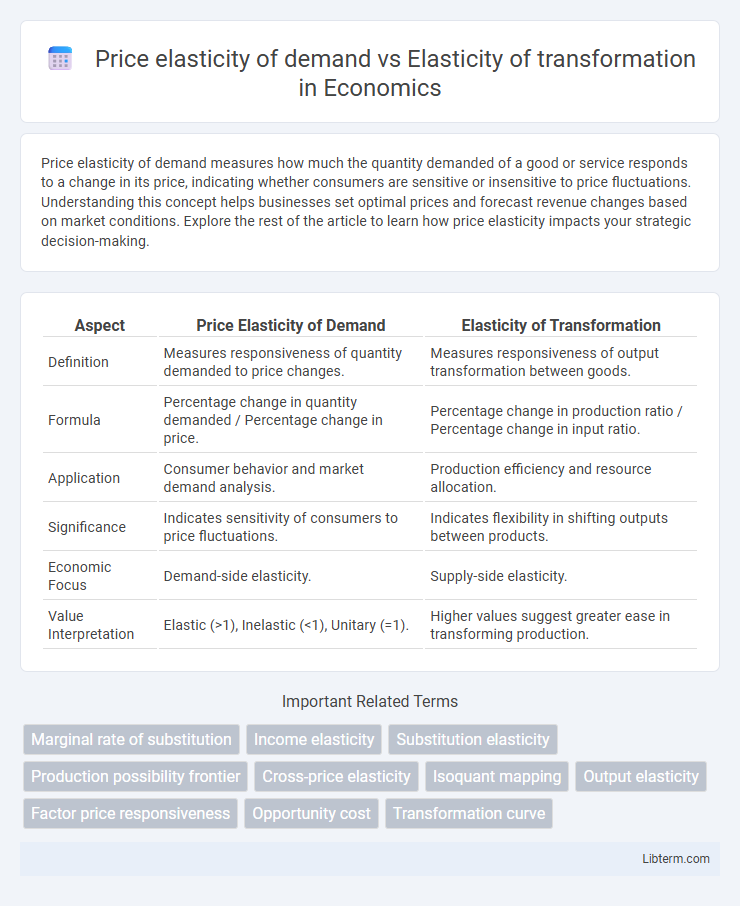Price elasticity of demand measures how much the quantity demanded of a good or service responds to a change in its price, indicating whether consumers are sensitive or insensitive to price fluctuations. Understanding this concept helps businesses set optimal prices and forecast revenue changes based on market conditions. Explore the rest of the article to learn how price elasticity impacts your strategic decision-making.
Table of Comparison
| Aspect | Price Elasticity of Demand | Elasticity of Transformation |
|---|---|---|
| Definition | Measures responsiveness of quantity demanded to price changes. | Measures responsiveness of output transformation between goods. |
| Formula | Percentage change in quantity demanded / Percentage change in price. | Percentage change in production ratio / Percentage change in input ratio. |
| Application | Consumer behavior and market demand analysis. | Production efficiency and resource allocation. |
| Significance | Indicates sensitivity of consumers to price fluctuations. | Indicates flexibility in shifting outputs between products. |
| Economic Focus | Demand-side elasticity. | Supply-side elasticity. |
| Value Interpretation | Elastic (>1), Inelastic (<1), Unitary (=1). | Higher values suggest greater ease in transforming production. |
Understanding Price Elasticity of Demand
Price elasticity of demand measures how the quantity demanded of a good responds to a change in its price, reflecting consumer sensitivity and purchasing behavior. This concept is crucial for businesses and policymakers to predict changes in revenue and market dynamics when prices fluctuate. Unlike elasticity of transformation, which analyzes producers' ability to switch outputs between products, price elasticity of demand directly captures consumer response in various markets.
Defining Elasticity of Transformation
Elasticity of transformation measures the responsiveness of output allocation between industries when relative prices change, reflecting the opportunity cost of reallocating resources. It quantifies the ease with which production factors can be shifted from one sector to another, influencing supply-side adjustments in multi-output models. Unlike price elasticity of demand, which focuses on consumer response to price changes, elasticity of transformation addresses the producer's capability to adapt production patterns across different goods.
Key Differences Between Price Elasticity of Demand and Elasticity of Transformation
Price elasticity of demand measures how the quantity demanded of a good responds to changes in its price, reflecting consumer sensitivity and market demand dynamics. Elasticity of transformation gauges the ability of producers to reallocate resources between the production of different goods, indicating flexibility in supply side adjustments. Key differences lie in their focus: price elasticity of demand addresses consumer behavior and demand responsiveness, while elasticity of transformation emphasizes production adaptability and resource allocation efficiency.
Factors Influencing Price Elasticity of Demand
Price elasticity of demand measures how quantity demanded responds to price changes, influenced by factors such as availability of substitutes, necessity of the good, and time horizon for adjustment. In contrast, elasticity of transformation assesses how easily resources can be reallocated between products in production, affected by technological flexibility and production constraints. Factors influencing price elasticity of demand include the proportion of income spent on the good, consumer preference strength, and the degree of market competition.
Determinants of Elasticity of Transformation
Determinants of elasticity of transformation primarily include the substitutability of inputs and the flexibility of production processes, which influence how easily resources can be reallocated between different outputs. Unlike price elasticity of demand, which depends on consumer preferences and income levels, elasticity of transformation is driven by technological constraints and input factor mobility. High elasticity of transformation allows producers to respond quickly to changes in relative output prices by adjusting their production mix efficiently.
Measurement Techniques for Both Elasticities
Price elasticity of demand is commonly measured using the midpoint formula, regression analysis, or percentage change methods to quantify consumer responsiveness to price variations, while elasticity of transformation is assessed through production possibility frontiers or cost functions to gauge the trade-off efficiency between outputs in multi-product firms. The measurement of price elasticity involves analyzing demand curves and historical sales data, whereas elasticity of transformation requires modeling technological constraints and resource allocation within the production process. Both elasticities employ econometric and mathematical optimization techniques, yet they target different aspects of market behavior and production capabilities.
Real-World Examples: Demand vs Transformation Elasticity
Price elasticity of demand measures how consumer quantity demanded responds to price changes, with real-world examples such as gasoline, where demand remains relatively inelastic due to necessity. Elasticity of transformation evaluates how producers can reallocate resources between goods, demonstrated in agriculture when farmers shift between planting corn or soybeans based on market prices. Understanding these elasticities aids businesses and policymakers in anticipating market reactions to price fluctuations and resource allocation decisions.
Importance in Economic Decision Making
Price elasticity of demand measures consumer responsiveness to price changes, guiding firms in setting optimal prices to maximize revenue. Elasticity of transformation assesses the ability of producers to reallocate resources between products, influencing production decisions and resource allocation efficiency. Both elasticities are critical in economic decision making as they provide insights into market behavior, helping businesses and policymakers predict outcomes and optimize strategies under varying economic conditions.
Impacts on Market Structure and Resource Allocation
Price elasticity of demand measures consumer responsiveness to price changes, directly influencing market competition by affecting product demand sensitivity and pricing strategies. Elasticity of transformation reflects the ease with which firms can reallocate resources between product outputs, shaping production flexibility and the market supply structure. Together, these elasticities determine resource allocation efficiency and competitive dynamics, impacting firms' capacity to respond to market shifts and optimize output combinations.
Policy Implications and Practical Applications
Price elasticity of demand measures consumer responsiveness to price changes, guiding policymakers in setting taxes and subsidies to optimize social welfare without causing excessive market distortion. Elasticity of transformation captures the ease with which producers switch between outputs, informing resource allocation policies and industry regulation to enhance production efficiency. Understanding both elasticities enables targeted interventions that balance consumer behavior and producer flexibility, promoting economic stability and growth.
Price elasticity of demand Infographic

 libterm.com
libterm.com